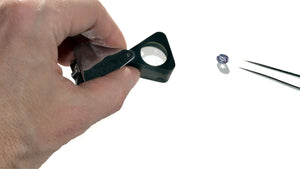Lab Grown Gems
When lab-grown gemstones started becoming more available to consumers and jewelers, I was skeptical and a little judgmental. I questioned the quality of the gems; I wondered what impact they had on the environment and poo-pooed them as “not real.” They’ve been on the market for a long time now. I’m much more open to them. The process of making them has improved, so their quality has improved. Some companies who make these gems are doing a good job of reducing negative environmental impacts. I put together some thoughts and facts on lab-create, or lab-grown, gems to give you a better understanding of them too.
Lab-created gemstones are real gemstones. They're not imitations. They are grown in a laboratory but are basically chemically, physically and optically identical to natural gems. The mineral composition of lab-created stones is created through a process similar to what nature does beneath the earth over millions of years, but in a lab, it’s done in a fraction of the time, and for a fraction of the cost of mining.
Process and Cost:
Natural gems usually have inclusions from the gasses and other minerals mixing in during the molten stage of the crystallization process. The lab-created stones rely on a steady, controlled process of applying minerals, heat and pressure, so they usually have fewer or no inclusions. In early years of the process, tiny air bubbles were sometimes in the gems, but the process has improved, and this isn’t an issue anymore.
These lab-grown gemstones are not inexpensive, just less so than their natural counterparts.
Environmental Pros and Cons:
Lab-grown gems use an enormous amount of electricity. Unless the lab is using renewable energy sources; and you can find labs that do run entirely on renewable energy. I recently heard about companies that are capturing carbon from the environment and turning them into diamonds.
Natural gemstones have environmental drawbacks. Gemstones are extracted by digging tons of dirt and rocks from pits/mines. An enormous amount of energy is used to dig the mines, and there are other negative impacts, from water quality for the people, animals and plants in the area, land degradation.
For some, the fact that lab-grown gems do away with concerns of blood diamonds is a deciding factor in choosing lab grown over mined.
Summary:
Lab-grown gemstones are made in a lab within a few weeks. Mother Nature takes millions, sometimes billions, of years to create gemstones. There is a shorter supply chain involved in getting the synthetic gems to consumers, and, it is presumed, the conditions of working in a lab are humane and safer than being a miner or one who extracts the natural gems. Downside, it does take an enormous amount of electricity for a lab to create a gemstone. Also, you might just really love a natural stone.
Another option: Buy second-hand gemstones. Using recycled silver or gold, along with second-hand gemstones, is a great way to ease your worries about harming the environment or humans.


